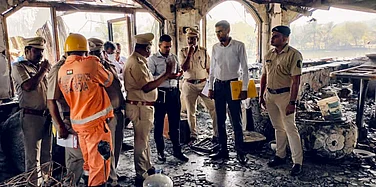At the mega environmental summit—the 2021 United Nations Climate Change Conference, commonly referred to as COP26—hosted by British Prime Minister Boris Johnson in Scotland last November, Prime Minister Narendra Modi laid out an ambitious roadmap of India’s climate action plan. Watched by the world’s who-is-who, Modi announced five significant decisions. India would take its non-fossil energy capacity to 500 GW by 2030. It would meet 50 per cent of its energy requirements from renewable energy by that date. India wold reduce the total projected carbon emissions by one billion tonnes by 2030. India would also reduce the carbon intensity of its economy by more than 45 per cent by the same year. Finally, he set 2070 as the timeline to achieve net-zero emission. “These panchamrits will be an unprecedented contribution of India to climate action,” Modi said. The US and most of Europe have pledged to achieve net-zero emission by 2050, while China has extended the deadline to 2060.
Modi’s announcement was India’s first major commitment to the idea of net-zero emission. Earlier, at the G-7 climate and environment ministers’ meet in June 2021, New Delhi had resisted the net-zero emission target, saying it was not part of the broader policy commitments. But by COP 26, there was a dramatic turnaround in New Delhi’s stand. Perhaps, India realised the importance of being on the right side of the global debate for a country with big power ambitions. There was tremendous pressure from leading Western powers for India to be onboard the emission targets. John Kerry, US President Joe Biden’s special envoy for climate, made at least two trips to New Delhi for consultations. As a country with over one billion people, what India does affects the world’s fight against climate change.
ALSO READ: Poetry: Letter From A Former Cook
But barely five months later, India’s commitments already appear to be under severe stress. With the country battered by a searing heatwave, which has in turn boosted demand for power, the Centre has decided to reopen more than 100 coal mines previously considered financially unsustainable, to fuel the country’s power plants. According to the government, the country expects to increase coal output by up to 100 million tonnes in the next three years by reopening the closed mines.
With pressing domestic compulsions, critics wonder if India will be in a position to deliver what it has promised by 2030. Switching to renewables is not easy, especially in a developing nation like India where there are competing claims on scarce resources. How difficult will it be for New Delhi to deliver on the ground, considering the new green technology is expensive and the money promised by the rich, industrialised nations has merely trickled in? None of them has so far stuck to the promise of providing the one billion dollars annually to poorer countries pledged in the Paris Climate meet in 2015.
ALSO READ: Dante’s Peak: Heatwave Horror In Photos
Lifting India’s teeming millions out of the vicious circle of poverty and giving citizens a decent life is the priority of every government. Development in the traditional sense means need for more energy. For countries like India and China—two of the world’s biggest greenhouse gas emitters—fossil fuel provides an easy answer. India and China are the world’s top oil importers.
Asked how realistic it is to expect cutting renewables by half by 2030, former foreign secretary Shyam Saran, who was involved in the early negotiations on climate action and was Manmohan Singh’s special envoy on climate change, says. “As I am not in the government, I do not know the inside details. We need green technology and an energy mix, hydel power is a good and clean source, so are nuclear and renewables like solar and wind. But green technology is expensive, so much will depend on how quickly new technology can be obtained at a reasonable rate.”
One of the selling points for the civil nuclear deal with the US was clean energy from nuclear power stations. However, the world is now gradually turning away from nuclear energy. Especially after the Fukushima radiation leaks in Japan in 2011 led to a backlash over nuclear power. Even countries like France, that gets over 70 per cent of its electricity from nuclear energy, are now committed to stop new nuclear plants. In India too, despite the promise of clean energy, there has been little progress. The French nuclear plant in Jaitapur in coastal Maharashtra is now more or less abandoned, thanks to public protests. The Fukushima disaster had also led to massive protests against the Russian-built Kudankulam nuclear power station in Tamil Nadu. The government, however, rode through the protests and the plant continues to supply electricity to Tamil Nadu since 2016.

The Prime Minister’s International Solar Alliance is a good initiative, but the technology has to be further streamlined as there are problems—sometimes with the panels, as well as days, especially during the monsoons, when the sky is overcast. Wind power has the same problems. The unreliability of both solar and wind as compared to fossil fuels is a major issue, as storage becomes a serious setback. Large battery packs are also very expensive. “To meet 50 per cent of its power requirements by 2030 from renewable energy, India will need to increase installed capacity of renewables to 700 GW. If India considers hydroelectricity as part of renewables, then it will need to increase new renewable capacity to 630 GW. This is an ambitious target, and will require cheap finance, removal of policy uncertainties and the development of storage technologies,” says Avantika Goswami, programme manager, climate change at the Centre for Science and Environment. She goes on to add, “The expansion of distributed renewable energy with storage systems is critical for improving energy access and reducing energy poverty. So, while there may be a transition process for grid integration of renewable energy, in the long run it is beneficial for the poor, particularly in remote rural regions.”
The climate debate
Developing nations consider the rich, industrialised countries responsible for global warming and say they bear special responsibility for cleaning up the globe. Earlier, nations like India and China would argue that they are not responsible for the present situation. But the blame game is getting the world nowhere towards finding an urgent solution. The need now is for the rich countries to extend financial help to developing nations. India believes that transfer of climate funds and low-cost technology are essential to power the transition to green energy. Modi raised this issue in Glasgow when he said, “India expects developed countries to provide climate finance of US$1 trillion at the earliest. Today, it is necessary that as we track the progress made in climate mitigation, we should also track climate finance. The proper justice would be that the countries which do not live up to their promises made on climate finance, pressure should be put on them.”
As always, the poor have to bear the brunt of a warming planet. Whether it is flash floods, heatwave or bitter cold, those who live in shanties are hit the hardest. Climate change-related displacements affect mainly the poor and the urban underclass. As India tries to gradually switch from coal to renewables, coal mining will come to a halt. The poor will be the hardest hit. Not just those working in the mines, but the ancillary industries and makeshift markets that grow around mining townships. “The energy transition will change the nature of employment and economic security in the country,” says Aditya Valiathan Pillai of the Centre for Policy Research (CPR), who tracks climate change.
“But it is not a simple, linear story. There are at least three angles to this. First, those employed in the fossil fuel industry, particularly in India’s coal-rich states, will have to look elsewhere for their livelihoods if India decides to take net-zero seriously in the coming decades. Governments will have to offer them safety nets, skills re-training and investments for a soft landing.” But there is also a positive side, she says. “The transition could well lead to a new generation of renewables manufacturing jobs. And third, an element frequently left out, is that an aggressive transition by India and other large emitters could reduce the frequency and magnitude of climate impacts, thus preventing people from entering the poverty spirals that come with them,” adds Pillai.
(This appeared in the print edition as "Zero-Sum Game")
ALSO READ



























